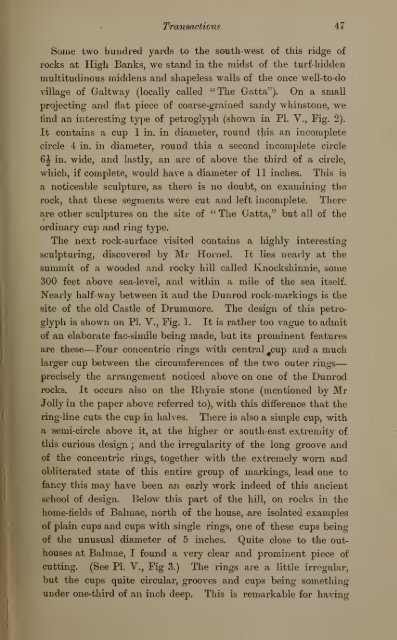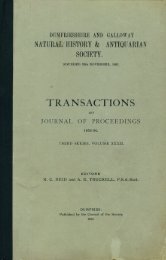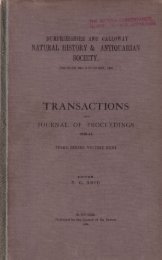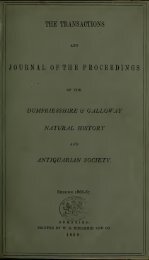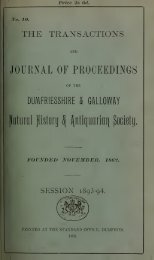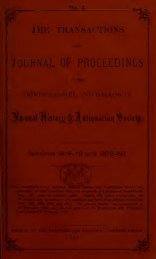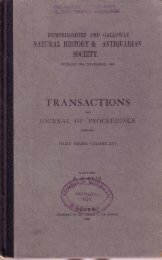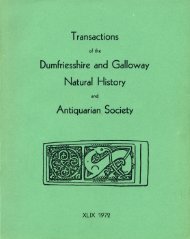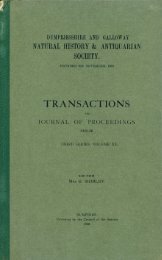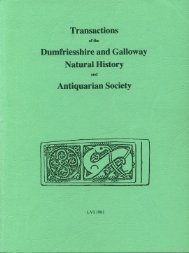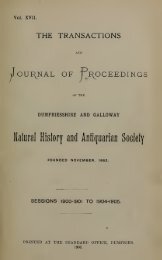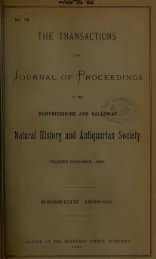Vol 5 - Dumfriesshire & Galloway Natural History and Antiquarian ...
Vol 5 - Dumfriesshire & Galloway Natural History and Antiquarian ...
Vol 5 - Dumfriesshire & Galloway Natural History and Antiquarian ...
Create successful ePaper yourself
Turn your PDF publications into a flip-book with our unique Google optimized e-Paper software.
—Transactions 47Some two hundred yards to the south-west of tliis ridge ofrocks at High Banks, we st<strong>and</strong> in the midst of the turf-hiddenmultitudinous middens <strong>and</strong> shapeless walls of the once well-to-dovillage of Galtway (locally called " The Gatta"). On a smallprojecting <strong>and</strong> flat piece of coarse-grained s<strong>and</strong>y whinstone, wefind an interesting type of petroglyph (shown in PI. V., Fig. 2).It contains a cup 1 in. in diameter, round this an incompletecircle 4 in. in diameter, round this a second incomplete circle6^ in. wide, <strong>and</strong> lastly, an arc of above the third of a circle,which, if complete, would have a diameter of 11 inches. This isa noticeable sculpture, as there is no doubt, on examining therock, that these segments were cut <strong>and</strong> left incomplete. Thereai-e other sculptures on the site of " The Gatta," but all of theordinary cup <strong>and</strong> ring type.The next rock-surface visited contains a highly interestingsculpturing, discovered by Mr Hornel. It lies nearly at thesummit of a wooded <strong>and</strong> rocky hill called Knockshinnie, some300 feet above sea-level, <strong>and</strong> within a mile of the sea itself.Nearly half-way between it <strong>and</strong> the Dunrod rock-markings is thesite of the old Castle of Drummore. The design of this petroglyphis shown on PL V., Fig. 1.It is rather too vague to admitof an elaborate fac-simile being made, but its prominent featuresare these—Four concentric rings with central cup <strong>and</strong> a muchlarger cup between the circumferences of the two outer ringsprecisely the arrangement noticed above on one of the Dunrodrocks. It occurs also on the Rhynie stone (mentioned by MrJolly in the paper above referred to), with this difference that thering-line cuts the cup in halves.There is also a simple cup, witha semi-circle above it, at the higher or south-east extremity ofthis curious design ; <strong>and</strong> the irregularity of the long groove <strong>and</strong>of the concentric rings, together with the extremely worn <strong>and</strong>obliterated state of this entire group of markings, lead one tofancy tliis may have been an early work indeed of thisancientschool of design. Below this part of the hill, on rocks in theliome-fields of Balmae, north of the house, are isolated examplesof plain cups <strong>and</strong> cups with single rings, one of these cups beingof the unusual diameter of 5 inches. Quite close to the outhousesat Balmae, I found a very clear <strong>and</strong> prominent piece ofcutting. (See PI. V., Fig 3.) The rings are a little irregular,but the cups quite circular, grooves <strong>and</strong> cups being somethingunder one-third of an inch deep. This is remarkable for having


